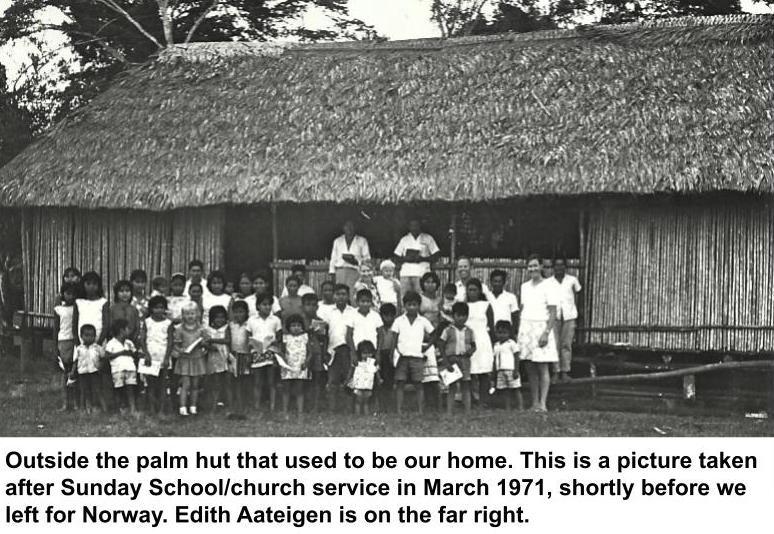Chapter 33: Building a Ministry and Building a House
Health work, New Believers, and Answers to Prayers
AS TOLD BY JOHN AGERSTEN
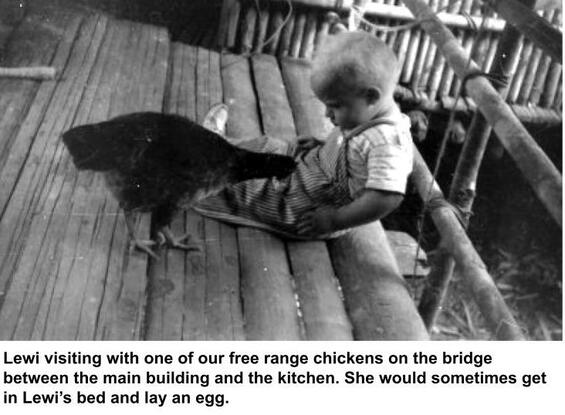
The Lord’s protection in answer to prayer
There were many dangers around us in the jungle, but in spite of this, we felt safe. It was a blessing and an encouragement to know that we had family and friends back in Norway lifting us up in prayer, especially during these pioneering times when everything was new and strange to us. We often experienced God’s supernatural protection and help in difficulties; no doubt this was a direct result of these prayers.
One night, for example, I woke up to a sound from the kitchen. Thinking it might be a dog or another uninvited guest who had gotten in under the cover of night, I got up and grabbed my flashlight. I left it unlit so I could sneak up on whatever was making the noise and tiptoed silently through the living room and across the bamboo bridge toward the kitchen. I was almost there when I suddenly felt a hand on my chest stopping me. I quickly turned on the flashlight, but there was no one there! As I lowered the light, however, I saw, right in front of my bare toes, a big, hairy tarantula spider poised to bite. It scurried away through a crack in the bamboo when I stomped my feet on the floor. My heart was thudding and I thanked God for his protection! The Peruvian species of tarantulas have a poisonous bite, and although it is not usually fatal to humans, it can cause a great deal of pain and there is always a danger of infection. I continued into the kitchen but did not see anything else. I guess I had just heard some rats.
Sometime later we received a letter from home asking if anything special had happened on that date. The writer had felt a strong compulsion to pray for us right then as if we were in danger. It was an awesome confirmation to us that the Lord was taking care of us.
There were many dangers around us in the jungle, but in spite of this, we felt safe. It was a blessing and an encouragement to know that we had family and friends back in Norway lifting us up in prayer, especially during these pioneering times when everything was new and strange to us. We often experienced God’s supernatural protection and help in difficulties; no doubt this was a direct result of these prayers.
One night, for example, I woke up to a sound from the kitchen. Thinking it might be a dog or another uninvited guest who had gotten in under the cover of night, I got up and grabbed my flashlight. I left it unlit so I could sneak up on whatever was making the noise and tiptoed silently through the living room and across the bamboo bridge toward the kitchen. I was almost there when I suddenly felt a hand on my chest stopping me. I quickly turned on the flashlight, but there was no one there! As I lowered the light, however, I saw, right in front of my bare toes, a big, hairy tarantula spider poised to bite. It scurried away through a crack in the bamboo when I stomped my feet on the floor. My heart was thudding and I thanked God for his protection! The Peruvian species of tarantulas have a poisonous bite, and although it is not usually fatal to humans, it can cause a great deal of pain and there is always a danger of infection. I continued into the kitchen but did not see anything else. I guess I had just heard some rats.
Sometime later we received a letter from home asking if anything special had happened on that date. The writer had felt a strong compulsion to pray for us right then as if we were in danger. It was an awesome confirmation to us that the Lord was taking care of us.

Ministering to the sick and threats from the local “brujo”
From the very beginning in Tigre Playa, people came to us for help with physical needs and illnesses of many different kinds. Soon, people were bringing us their sick from other villages along the Marañon, and with time, the rumor that there was a white “doctor” or “medicine man” in Tigre Playa spread as far as the tributaries of Potro and Morona, and further up the Marañon. I had taken a one-year course in Norway for nurse’s aids at the Aker Hospital, so at least I had some very basic knowledge about first aid and caring for the sick. However, my meager health education was not adequate for the challenges that met us here. We had to learn a lot as we went along. As mentioned in a previous chapter, we had realized on our trip in the houseboat that healthcare was a big need in this area, so we had fortunately brought with us a good amount of medications and first aid supplies from Yurimaguas.
We soon found out that a “brujo” lived in Tigre Playa. A “brujo” was the local name for a shaman or medicine man. He was well known and feared in the village for his occult practices. He was not in favor of us settling in the village; maybe he felt we would be competition. Some neighbors came to us one day and told us that the “brujo” had threatened that he would kill us with illness, first the children, then us adults. They were sincerely worried about what would happen to us since they were afraid of him.
A couple of nights later, we heard him walk around our house. He was cursing us and mumbled and sang in an unknown language. Of course, we felt very uncomfortable and prayed for God’s protection. A verse from the Bible came to us: John 4:4 “He who is in you is greater than he who is in the world.” That word gave us the comfort we needed and we felt safe.
Not long after this, we heard that his daughter had been bitten on the arm by a venomous snake. The arm swelled up, and she became very ill. The dad tried to heal her with his tricks but without success. One day when he was not at home, the mother brought her to us and asked for our help. The arm had developed a severe infection, so we treated the wound and gave her penicillin. With the mother’s approval, we also prayed over her. She improved quickly, although it took a while for the arm to become completely normal again.
Their son also became ill, and we were told that the “brujo’s” wife told him: “The curse you tried to put on them has come upon us’” She left him and returned to her family’s village. Shortly thereafter, he also packed up and moved. Many in the village were glad to see him go, and we felt that the atmosphere was lighter and freer without him.
From the very beginning in Tigre Playa, people came to us for help with physical needs and illnesses of many different kinds. Soon, people were bringing us their sick from other villages along the Marañon, and with time, the rumor that there was a white “doctor” or “medicine man” in Tigre Playa spread as far as the tributaries of Potro and Morona, and further up the Marañon. I had taken a one-year course in Norway for nurse’s aids at the Aker Hospital, so at least I had some very basic knowledge about first aid and caring for the sick. However, my meager health education was not adequate for the challenges that met us here. We had to learn a lot as we went along. As mentioned in a previous chapter, we had realized on our trip in the houseboat that healthcare was a big need in this area, so we had fortunately brought with us a good amount of medications and first aid supplies from Yurimaguas.
We soon found out that a “brujo” lived in Tigre Playa. A “brujo” was the local name for a shaman or medicine man. He was well known and feared in the village for his occult practices. He was not in favor of us settling in the village; maybe he felt we would be competition. Some neighbors came to us one day and told us that the “brujo” had threatened that he would kill us with illness, first the children, then us adults. They were sincerely worried about what would happen to us since they were afraid of him.
A couple of nights later, we heard him walk around our house. He was cursing us and mumbled and sang in an unknown language. Of course, we felt very uncomfortable and prayed for God’s protection. A verse from the Bible came to us: John 4:4 “He who is in you is greater than he who is in the world.” That word gave us the comfort we needed and we felt safe.
Not long after this, we heard that his daughter had been bitten on the arm by a venomous snake. The arm swelled up, and she became very ill. The dad tried to heal her with his tricks but without success. One day when he was not at home, the mother brought her to us and asked for our help. The arm had developed a severe infection, so we treated the wound and gave her penicillin. With the mother’s approval, we also prayed over her. She improved quickly, although it took a while for the arm to become completely normal again.
Their son also became ill, and we were told that the “brujo’s” wife told him: “The curse you tried to put on them has come upon us’” She left him and returned to her family’s village. Shortly thereafter, he also packed up and moved. Many in the village were glad to see him go, and we felt that the atmosphere was lighter and freer without him.
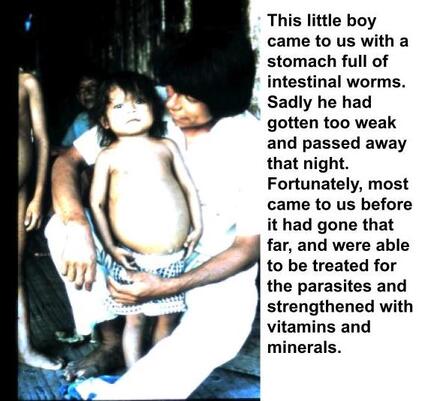
Over the next few years, the health ministry in Tigre Playa continued to develop. We bought another abandoned hut next to us, and it became a place for the sick and their families to spend the night. With time, we built a couple of bigger bamboo huts on the lot. Here the sick and their families could stay for as long as they needed. They usually brought with them their own food such as manioc, bananas, dried fish or meat, and cooked it over an open fire just like they would at home. They also came to the services and heard the Word of God. Many asked for prayer for both their health and salvation.
We learned a lot during these years, both from experience and from reading medical encyclopedias and books that dealt particularly with tropical diseases. In time, we started buying medications in bulk from medical distributors in Iquitos further down the Marañon. Later, in the mid-1970s, we also received medications, vitamins, and supplies from Norway and Switzerland in special shipments. Over the years our connections with the Wycliffe Bible Translators increased, and we started having daily ham radio contact with them and became a refueling station for the small planes they used to transport their missionaries around the jungle. They had a small hospital with doctors and nurses on their base in Pucallpa, so we could contact them through the ham radio when we needed advice and help. This was truly a blessing. But these early days when we were on our own, we relied heavily on the Holy Spirit to help us with the different challenges people brought to us.
We learned a lot during these years, both from experience and from reading medical encyclopedias and books that dealt particularly with tropical diseases. In time, we started buying medications in bulk from medical distributors in Iquitos further down the Marañon. Later, in the mid-1970s, we also received medications, vitamins, and supplies from Norway and Switzerland in special shipments. Over the years our connections with the Wycliffe Bible Translators increased, and we started having daily ham radio contact with them and became a refueling station for the small planes they used to transport their missionaries around the jungle. They had a small hospital with doctors and nurses on their base in Pucallpa, so we could contact them through the ham radio when we needed advice and help. This was truly a blessing. But these early days when we were on our own, we relied heavily on the Holy Spirit to help us with the different challenges people brought to us.
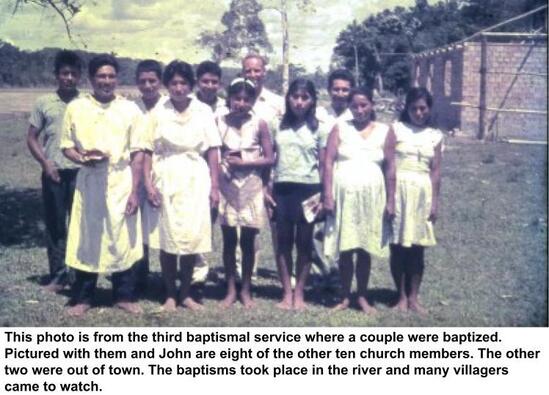
Ministering to the spiritual needs
Although the healthcare side of the ministry was important and often time-consuming, our primary aim was to minister to the spiritual needs of the people, and we were seeing progress in that area as well. We could feel the Lord giving us strength and blessing the work. New people came to the services on a regular basis, and several committed themselves to the Lord. We had our first baptismal service one Sunday in April 1970, about three and a half months after settling here in Tigre Playa, and this brought us great joy. Six people were baptized, a married couple and four young people. They were some of the first converts and they were strongly committed to the Lord and we could see their spiritual growth. There were still others interested in being baptized, but they wanted to be legally married first, so we were able to hold another baptismal service in June where two couples were baptized. It was a beautiful moment to welcome them as members of the church. There were now ten members besides ourselves. We had a service with just them and it was a blessing to share communion and feel the Lord’s presence with us in a special way. We may not have had large congregations, but it was great to see the Lord working in the lives of the people in the jungle. Songs of praise and prayers could be heard from simple bamboo huts both here in Tigre Playa and in other villages.
Although the healthcare side of the ministry was important and often time-consuming, our primary aim was to minister to the spiritual needs of the people, and we were seeing progress in that area as well. We could feel the Lord giving us strength and blessing the work. New people came to the services on a regular basis, and several committed themselves to the Lord. We had our first baptismal service one Sunday in April 1970, about three and a half months after settling here in Tigre Playa, and this brought us great joy. Six people were baptized, a married couple and four young people. They were some of the first converts and they were strongly committed to the Lord and we could see their spiritual growth. There were still others interested in being baptized, but they wanted to be legally married first, so we were able to hold another baptismal service in June where two couples were baptized. It was a beautiful moment to welcome them as members of the church. There were now ten members besides ourselves. We had a service with just them and it was a blessing to share communion and feel the Lord’s presence with us in a special way. We may not have had large congregations, but it was great to see the Lord working in the lives of the people in the jungle. Songs of praise and prayers could be heard from simple bamboo huts both here in Tigre Playa and in other villages.
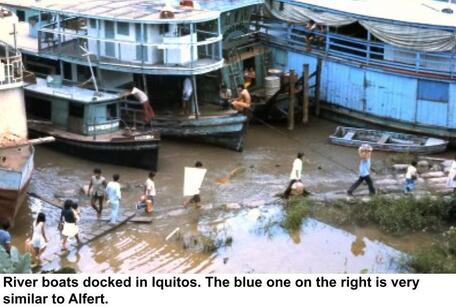
Building a new home
Even as we moved into the bamboo hut when we arrived in Tigre Playa, we knew we wanted to build a new, more solid home out of bricks since we were planning to stay long term. How quickly this would happen, was dependent on receiving extra funds for this in addition to what we could spare from our regular financial support. Time was flying by, and we wanted to complete it as soon as possible before the relief missionaries arrived so we could return to Norway on furlow for a year.
Something that was going to be a big help with this project was the riverboat “Alfert”. About the same time we came to Tigre Playa, it started a route that ran every 14 days between the city of Iquitos downriver and Puerto America, a larger village at the mouth of the Morona. That connection with a city was truly a blessing for us. In February, John had set up a post box for us in Iquitos and gave the key to the owner of the riverboat. During all the years we lived in Tigre Playa, we paid him to take letters we needed to be mailed to Iquitos, and he brought us back the mail that had arrived for us in the post box. We were very satisfied with the arrangement. The riverboat would also carry other wares we had purchased in town, such as medications, groceries, and materials for the house. There was always great excitement when Alfert arrived with wares and materials for us. Usually, he had to dock 200 - 300 yards from our house due to the sandbank, but that was not a problem. We always found many willing hands to help carry things from the boat to our property for a small price.
Even as we moved into the bamboo hut when we arrived in Tigre Playa, we knew we wanted to build a new, more solid home out of bricks since we were planning to stay long term. How quickly this would happen, was dependent on receiving extra funds for this in addition to what we could spare from our regular financial support. Time was flying by, and we wanted to complete it as soon as possible before the relief missionaries arrived so we could return to Norway on furlow for a year.
Something that was going to be a big help with this project was the riverboat “Alfert”. About the same time we came to Tigre Playa, it started a route that ran every 14 days between the city of Iquitos downriver and Puerto America, a larger village at the mouth of the Morona. That connection with a city was truly a blessing for us. In February, John had set up a post box for us in Iquitos and gave the key to the owner of the riverboat. During all the years we lived in Tigre Playa, we paid him to take letters we needed to be mailed to Iquitos, and he brought us back the mail that had arrived for us in the post box. We were very satisfied with the arrangement. The riverboat would also carry other wares we had purchased in town, such as medications, groceries, and materials for the house. There was always great excitement when Alfert arrived with wares and materials for us. Usually, he had to dock 200 - 300 yards from our house due to the sandbank, but that was not a problem. We always found many willing hands to help carry things from the boat to our property for a small price.
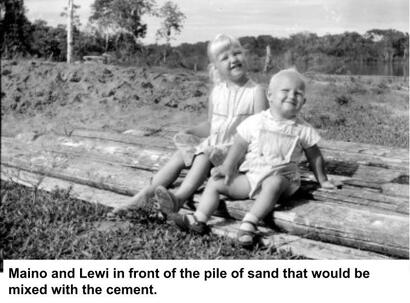
Delayed by rain and floods
In a letter home on March 11th, I wrote: “Today the river boat arrived with 50 bags of cement. Now we can start pouring the foundations for the walls. Later, we plan to buy bricks for the walls themselves. How quickly we can build depends on the funds that come in for the project.”
Soon we realized, however, that the construction work did not just depend on funds, but also on the weather and the river. In April, it rained almost every day. It was as if the sky would never run out of water! The river was rising again, and this time it came up higher than the last time, and soon it overflowed its banks and we were wading in water just outside the house.
Gro writes in a letter home on the 30th of April: “Most of the work on the house has stopped now in the rain. The house has the beginnings of a foundation but is full of water. The river has reclaimed the mound of sand we had gathered from the sandbank. All we can do now is wait for the waters to recede so we can gather new sand. Please pray that we can soon resume the construction and that sufficient funds will come in.”
In a letter home on March 11th, I wrote: “Today the river boat arrived with 50 bags of cement. Now we can start pouring the foundations for the walls. Later, we plan to buy bricks for the walls themselves. How quickly we can build depends on the funds that come in for the project.”
Soon we realized, however, that the construction work did not just depend on funds, but also on the weather and the river. In April, it rained almost every day. It was as if the sky would never run out of water! The river was rising again, and this time it came up higher than the last time, and soon it overflowed its banks and we were wading in water just outside the house.
Gro writes in a letter home on the 30th of April: “Most of the work on the house has stopped now in the rain. The house has the beginnings of a foundation but is full of water. The river has reclaimed the mound of sand we had gathered from the sandbank. All we can do now is wait for the waters to recede so we can gather new sand. Please pray that we can soon resume the construction and that sufficient funds will come in.”
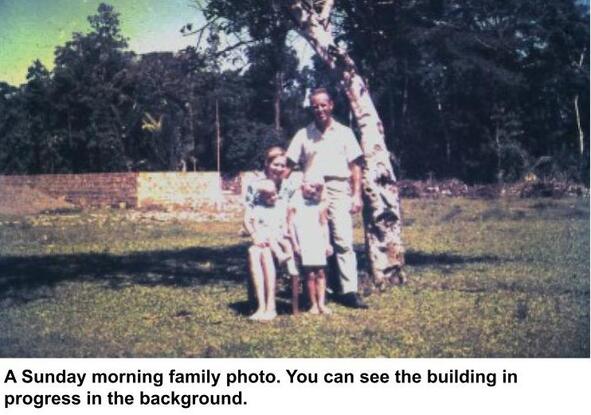
The sinking of a boatload of bricks
One day Alfert arrived from Iquitos with a load of bricks for the house. About 7000 bricks were stacked at the side of the river where the riverboat had docked. I got help to load some of the bricks at a time into our large canoe so we could transport them upriver to the construction site. The water there was too shallow for the riverboat, but not a problem for the canoe with its small outboard motor.
I had taken a couple of trips up and down when it was time to go home and eat lunch. Some of the helpers stayed to load the canoe for another trip. When I returned, they had loaded a lot of bricks in the boat, leaving it very low in the water. Lewi, who was about two years old, wanted to ride with me, but I was nervous about how heavily it was loaded and told him no. I started the motor and pulled slowly away from land. Suddenly I felt my feet getting wet! Water was coming in at the front of the canoe. I turned back toward land, but the boat sank under me before I reached the riverbank and I had to swim ashore. Maino and Lewi watched with fright in their eyes as the boat and the bricks disappeared under the water. I was so thankful they had not been on board with me!
We found the canoe at a depth of 6 to 7 feet right at the shore. It had gone straight into the riverbank like a torpedo. The outboard motor was attached with a chain and a bolt at the back. The current was strong and the water was so murky that I could not even see my hand in front of me. We put down a long pole next to the boat, so I could use it to hold on to as I tried to retrieve the motor. I dived down with tools in both hands and hung onto the pole by my knees while I worked so I would not be pulled downriver by the current. After several trips to the surface for air, I finally managed to unscrew the bolt. I was very relieved when the motor was finally back on land where it was taken apart and laid in the sun to dry. Luckily, the electrical parts had not been damaged, so we were able to get it started again after working with it for a while.
The next day, two other men helped me dive for the bricks, and we retrieved most of them. Once the canoe was free of its load, it floated back up again undamaged. All three of us were exhausted but relieved that most of the load, the boat itself, and the motor had all been retrieved from the river. After that, I was very careful not to overload the boat!
One day Alfert arrived from Iquitos with a load of bricks for the house. About 7000 bricks were stacked at the side of the river where the riverboat had docked. I got help to load some of the bricks at a time into our large canoe so we could transport them upriver to the construction site. The water there was too shallow for the riverboat, but not a problem for the canoe with its small outboard motor.
I had taken a couple of trips up and down when it was time to go home and eat lunch. Some of the helpers stayed to load the canoe for another trip. When I returned, they had loaded a lot of bricks in the boat, leaving it very low in the water. Lewi, who was about two years old, wanted to ride with me, but I was nervous about how heavily it was loaded and told him no. I started the motor and pulled slowly away from land. Suddenly I felt my feet getting wet! Water was coming in at the front of the canoe. I turned back toward land, but the boat sank under me before I reached the riverbank and I had to swim ashore. Maino and Lewi watched with fright in their eyes as the boat and the bricks disappeared under the water. I was so thankful they had not been on board with me!
We found the canoe at a depth of 6 to 7 feet right at the shore. It had gone straight into the riverbank like a torpedo. The outboard motor was attached with a chain and a bolt at the back. The current was strong and the water was so murky that I could not even see my hand in front of me. We put down a long pole next to the boat, so I could use it to hold on to as I tried to retrieve the motor. I dived down with tools in both hands and hung onto the pole by my knees while I worked so I would not be pulled downriver by the current. After several trips to the surface for air, I finally managed to unscrew the bolt. I was very relieved when the motor was finally back on land where it was taken apart and laid in the sun to dry. Luckily, the electrical parts had not been damaged, so we were able to get it started again after working with it for a while.
The next day, two other men helped me dive for the bricks, and we retrieved most of them. Once the canoe was free of its load, it floated back up again undamaged. All three of us were exhausted but relieved that most of the load, the boat itself, and the motor had all been retrieved from the river. After that, I was very careful not to overload the boat!
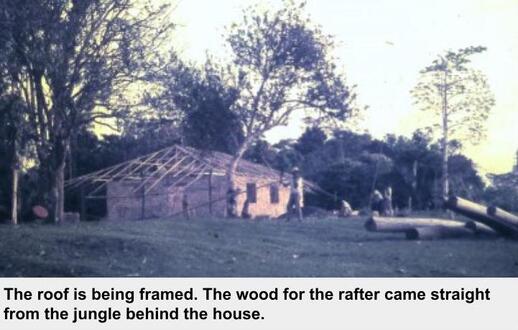
The construction continues
When the river receded after the flooding at the end of May, we were able to gather more sand and continue with the construction. It was good to see the walls coming up row by row. Once the walls were up, we prepared to pour the concrete floor. In faith that we would be able to have running water indoor, I laid down drain pipes for the kitchen, toilet, and shower. All the concrete was mixed by hand, but we had a lot of help. Many wanted to earn a little extra money, but they all needed to be taught since no one had ever mixed concrete before. It was hard work under the tropical sun. One day, I lay a thermometer on the sandpile, and it rose to 60 degrees Celcius before exploding! No wonder we were sweating a lot! Unfortunately, I was not careful to drink enough water, something that led to some kidney problems a few years later.
We cut wood from the jungle for the rafters and were thrilled when the corrugated tin roof was finally in place. We had bought ceiling tiles from Iquitos. This helped insulate the house from the heat of the tin roof, and also helped keep out insects and rats. We installed metal screens in the window openings(there was no glass), and later added shutters to the windows facing the river since most of the wind and rain came from that direction.
When the river receded after the flooding at the end of May, we were able to gather more sand and continue with the construction. It was good to see the walls coming up row by row. Once the walls were up, we prepared to pour the concrete floor. In faith that we would be able to have running water indoor, I laid down drain pipes for the kitchen, toilet, and shower. All the concrete was mixed by hand, but we had a lot of help. Many wanted to earn a little extra money, but they all needed to be taught since no one had ever mixed concrete before. It was hard work under the tropical sun. One day, I lay a thermometer on the sandpile, and it rose to 60 degrees Celcius before exploding! No wonder we were sweating a lot! Unfortunately, I was not careful to drink enough water, something that led to some kidney problems a few years later.
We cut wood from the jungle for the rafters and were thrilled when the corrugated tin roof was finally in place. We had bought ceiling tiles from Iquitos. This helped insulate the house from the heat of the tin roof, and also helped keep out insects and rats. We installed metal screens in the window openings(there was no glass), and later added shutters to the windows facing the river since most of the wind and rain came from that direction.
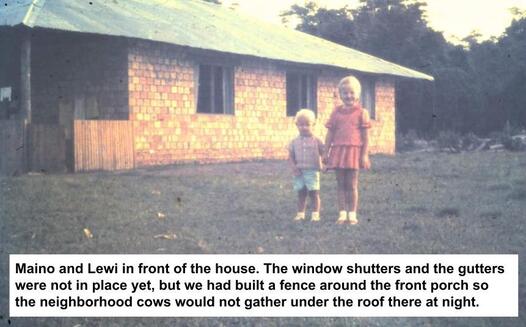
It was not going to be easy to find someone to plaster the walls and polish the floors around here, and I did not feel that I would be skilled enough to do a good job of it. So when someone told me there was a man living in a nearby village who had learned those skills while living in Iquitos, I did not hesitate to contact him right away. He was willing to come and we came to an agreement about the price. It turned out that he really was skilled, and both the polished cement floor and the interior walls looked very nice when he was finished.
We still needed to paint walls and ceilings, but we couldn’t wait to move in, and the 2nd of November 1970 was the big day! It was so nice to leave the bamboo hut and be in a solid house again and we were truly grateful! We would not miss the rats, roaches, and other critters, and although an occasional mosquito or roach got in, we could sleep without mosquito netting. Eventually, we would also have running water from the brick and cement water tank I had built at the back of the house. It would collect rainwater from the gutters around the roof. However, we moved in before we bought and installed the gutters so we had to wait for a little while for that luxury. It was now just over a year since we left Borja in the houseboat “El Sembrador”, looking for a place where we could establish a base for the mission work in the jungle, and about 10 months had passed since we settled in Tigre Playa and moved into the bamboo hut.
We still needed to paint walls and ceilings, but we couldn’t wait to move in, and the 2nd of November 1970 was the big day! It was so nice to leave the bamboo hut and be in a solid house again and we were truly grateful! We would not miss the rats, roaches, and other critters, and although an occasional mosquito or roach got in, we could sleep without mosquito netting. Eventually, we would also have running water from the brick and cement water tank I had built at the back of the house. It would collect rainwater from the gutters around the roof. However, we moved in before we bought and installed the gutters so we had to wait for a little while for that luxury. It was now just over a year since we left Borja in the houseboat “El Sembrador”, looking for a place where we could establish a base for the mission work in the jungle, and about 10 months had passed since we settled in Tigre Playa and moved into the bamboo hut.
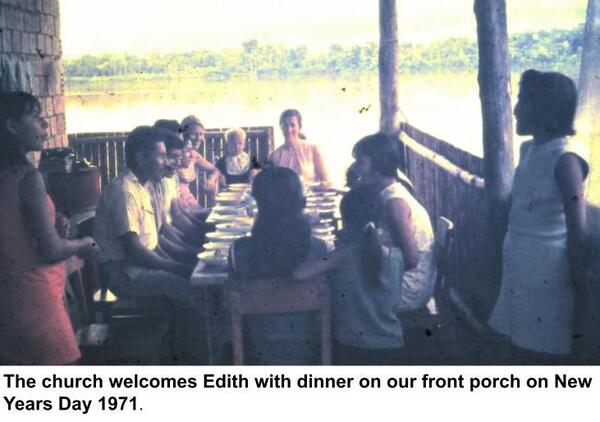
Edith Aateigen joins us
On November 8th, just a few days after moving in, I had to travel to Lima to meet missionary Edith Aateigen who was coming from Norway. She along with another missionary lady would be our relief when we went back to Norway for furlow in March 1971. The other missionary would join Edith here in Tigre Playa later.
It was nice to know that while I was gone for a while, Gro and the children were in a solid house. Some of the young people in the church helped with the interior painting during that time. They did not have much experience, but they did a good job. As it turned out, I was gone longer than planned due to delays in paperwork and customs, but Edith and I finally arrived in Tigre Playa on December 23rd.
We celebrated Christmas Eve with great joy in the new house, and on Christmas Day we celebrated with children and adults from the village in the bamboo hut. It would continue to serve as the church until we built a new church building after our return from Norway. The Sunday school children performed a little Nativity play they had rehearsed, and everyone enjoyed the food and the small gifts for the children. It was the first Christmas celebration in the village. On New Year's Day, we had another smaller church dinner as we officially welcomed Edith.
For the next few months, Edith would be with us and getting to know the place and the people before we left for Norway in the spring. We were looking forward to her working with us and very happy she had come.
On November 8th, just a few days after moving in, I had to travel to Lima to meet missionary Edith Aateigen who was coming from Norway. She along with another missionary lady would be our relief when we went back to Norway for furlow in March 1971. The other missionary would join Edith here in Tigre Playa later.
It was nice to know that while I was gone for a while, Gro and the children were in a solid house. Some of the young people in the church helped with the interior painting during that time. They did not have much experience, but they did a good job. As it turned out, I was gone longer than planned due to delays in paperwork and customs, but Edith and I finally arrived in Tigre Playa on December 23rd.
We celebrated Christmas Eve with great joy in the new house, and on Christmas Day we celebrated with children and adults from the village in the bamboo hut. It would continue to serve as the church until we built a new church building after our return from Norway. The Sunday school children performed a little Nativity play they had rehearsed, and everyone enjoyed the food and the small gifts for the children. It was the first Christmas celebration in the village. On New Year's Day, we had another smaller church dinner as we officially welcomed Edith.
For the next few months, Edith would be with us and getting to know the place and the people before we left for Norway in the spring. We were looking forward to her working with us and very happy she had come.
